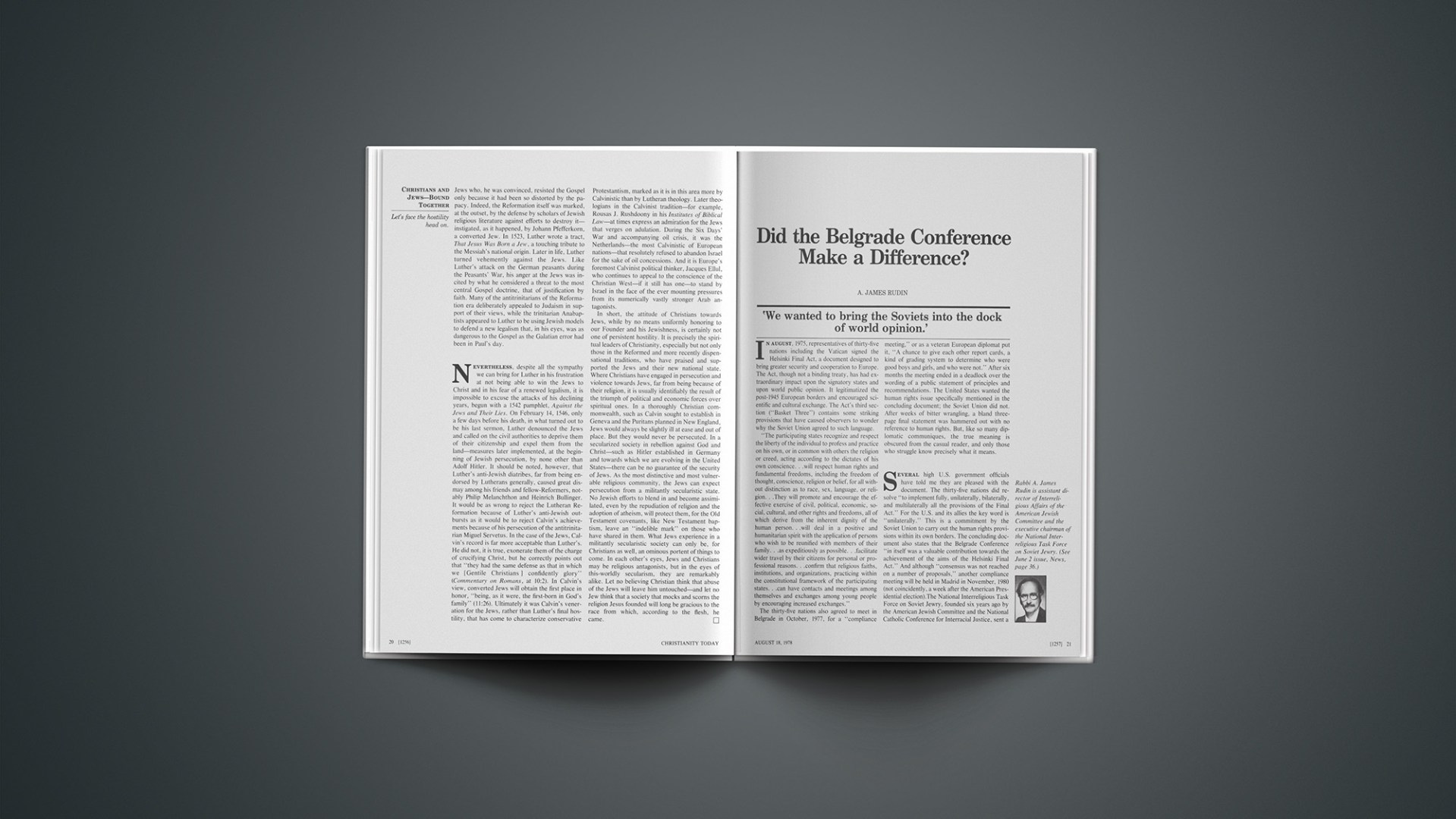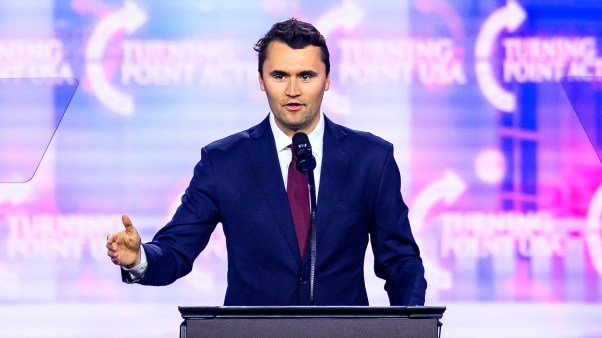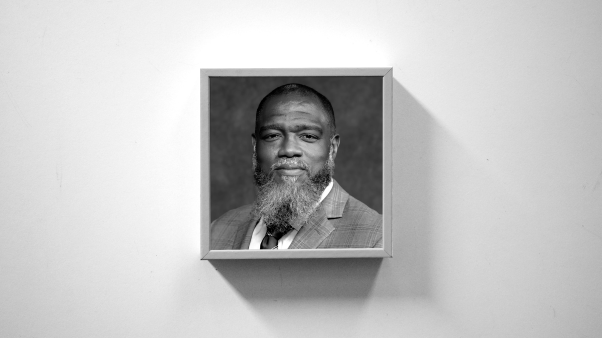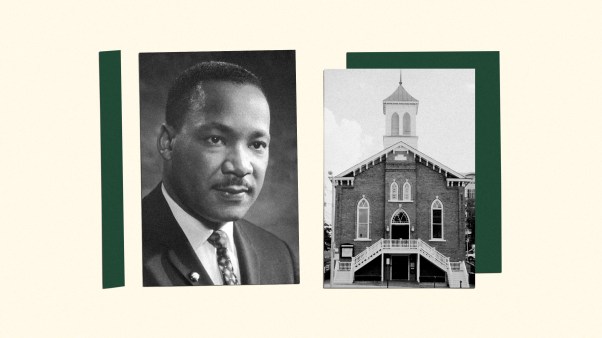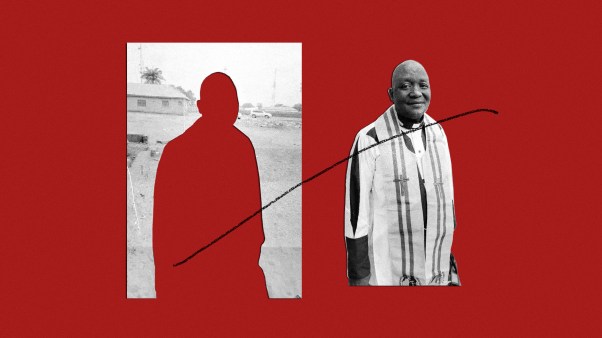A first-hand report.
‘We wanted to bring the Soviets into the dock of world opinion.’
In august, 1975, representatives of thirty-five nations including the Vatican signed the Helsinki Final Act, a document designed to bring greater security and cooperation to Europe. The Act, though not a binding treaty, has had extraordinary impact upon the signatory states and upon world public opinion. It legitimatized the post-1945 European borders and encouraged scientific and cultural exchange. The Act’s third section (“Basket Three”) contains some striking provisions that have caused observers to wonder why the Soviet Union agreed to such language.
“The participating states recognize and respect the liberty of the individual to profess and practice on his own, or in common with others the religion or creed, acting according to the dictates of his own conscience … will respect human rights and fundamental freedoms, including the freedom of thought, conscience, religion or belief, for all without distinction as to race, sex, language, or religion … They will promote and encourage the effective exercise of civil, political, economic, social, cultural, and other rights and freedoms, all of which derive from the inherent dignity of the human person … will deal in a positive and humanitarian spirit with the application of persons who wish to be reunified with members of their family … as expeditiously as possible … facilitate wider travel by their citizens for personal or professional reasons … confirm that religious faiths, institutions, and organizations, practicing within the constitutional framework of the participating states … can have contacts and meetings among themselves and exchanges among young people by encouraging increased exchanges.”
The thirty-five nations also agreed to meet in Belgrade in October, 1977, for a “compliance meeting,” or as a veteran European diplomat put it, “A chance to give each other report cards, a kind of grading system to determine who were good boys and girls, and who were not.” After six months the meeting ended in a deadlock over the wording of a public statement of principles and recommendations. The United States wanted the human rights issue specifically mentioned in the concluding document; the Soviet Union did not. After weeks of bitter wrangling, a bland three-page final statement was hammered out with no reference to human rights. But, like so many diplomatic communiques, the true meaning is obscured from the casual reader, and only those who struggle know precisely what it means.
Several high U.S. government officials have told me they are pleased with the document. The thirty-five nations did resolve “to implement fully, unilaterally, bilaterally, and multilaterally all the provisions of the Final Act.” For the U.S. and its allies the key word is “unilaterally.” This is a commitment by the Soviet Union to carry out the human rights provisions within its own borders. The concluding document also states that the Belgrade Conference “in itself was a valuable contribution towards the achievement of the aims of the Helsinki Final Act.” And although “consensus was not reached on a number of proposals,” another compliance meeting will be held in Madrid in November, 1980 (not coincidently, a week after the American Presidential election). The National Interreligious Task Force on Soviet Jewry, founded six years ago by the American Jewish Committee and the National Catholic Conference for Interracial Justice, sent a seven-person delegation during the Belgrade Conference to press for full implementation of Basket Three. The group represented evangelicals, mainline Protestants, Catholics, and Jews, and was made up of clergy and lay people, men and women, blacks and whites—a microcosm of America’s religious communities. From the moment the Interreligious Task Force arrived in the Yugoslavian capital, it was clear that Basket Three and the issue of human rights dominated the proceedings.
While in Belgrade the Task Force met with the leaders of six delegations (the United States, Great Britain, Holland, Spain, the Vatican, and Hungary), as well as with Senator Robert Dole, Senator Claiborne Pell, and Representative Millicent Fenwick. Fenwick and Senator Clifford Case were the coauthors of the bill that established the official United States “watchdog” commission, an extremely valuable body that collects and publishes data, complaints, and testimony relating to the Final Act’s many provisions.
The Helsinki Final Act is best understood as a rough equation: Basket One (borders) plus Basket Two (technical and scientific exchange) equals Basket Three (human rights and religious liberty). Most Western and neutral countries agreed with the arithmetic, but the Soviet Union and many of the Eastern European nations did not, hence the great difficulty in agreeing on a statement of consensus in Belgrade.
Everywhere the American religious leaders went in Belgrade’s sleek new Sava Conference Center they heard the same question: “How serious is the United States’s commitment to human rights and how much is the Soviet Union willing to yield on this issue to gain the advantages of Baskets One and Two?” Our Western allies (the NATO and Common Market countries) were all more or less committed to Basket Three (who, after all, in the so-called Free World is opposed to human rights?). The real question was what price does a Western nation have to pay vis-à-vis the Soviet Union for its pro-Basket Three stance? Will it suffer economically? Will the Soviet Union threaten it militarily or diplomatically?
Just as the United States provides a “nuclear shield” for the West, so, too, at Belgrade our government supplied our allies with a “human rights shield.” Wielding that shield and leading the campaign against the Soviet Union was the head of the American delegation, Justice Arthur J. Goldberg, a personal appointment of President Carter. Goldberg was the only diplomat of international stature and reputation at the conference. The other thirty-four nations sent middle-level foreign service types to Belgrade, a clear reflection of their view of the conference.
Because of Justice Goldberg’s vigorous leadership and his long involvement in the struggle for human rights and religious liberty, there was a tendency at Belgrade to “let Arthur do it.” He was the one diplomat who publicly cited the names of Soviet Jews and Christians who are “Prisoners of Conscience,” he listed the dates of arrest, the jails where the prisoners are being held, and the alleged charges against them. Goldberg put the muscles, sinews, and flesh of specificity onto the skeleton of abstract commitment to human rights. Justice Goldberg clearly dominated the Sava Center as he attempted to rally the timid and diffident, the fence-sitters, and the human rights relativists. His acknowledged mediation skills were a great asset as he dealt with such disparate states as San Marino, the Soviet Union, Canada, Bulgaria, Malta, and the Vatican.
The Holy See pursued a delicate and highly nuanced policy at Belgrade. One of the Vatican officials in Belgrade stated it most clearly to the visiting Interreligious Task Force delegates: “We were aggressively against the Soviet Union after World War II … in Italy, in Hungary, Poland, many places. Now we have shifted to nonpublicized interventions in human rights. Of course, we are committed to religious liberty and Basket Three, but by quiet diplomacy, at the right time and the right place—efficacy, efficacy, that’s the important thing.”
Pope Paul’s public condemnation of the recent trials of Soviet dissidents was especially welcome since we were told in Belgrade not to expect any statements or public interventions from the Vatican that call attention to the many Christian and Jewish prisoners in the Soviet Union.
If Arthur Goldberg was the central personality present at Belgrade, there were two persons who hovered over the Sava Center like Banquo’s ghost in Macbeth. One was Anatoly Shcharansky, the imprisoned young Soviet Jewish engineer. His case was mentioned often, especially by the American delegation, at both the public and private conference sessions, as well as in the corridors. Shcharansky, charged with treason by the Soviet authorities, had been held in jail for over a year without a trial and without the right to select his own attorney. He has been called a “CIA agent,” a charge that President Carter has publicly denied. Shcharansky is a leader in the Soviet Jewish activist community and he is also a key member of the ad hoc Helsinki monitoring groups that have been set up inside the Soviet Union. Thus, Shcharansky represents both symbolically and actually two important forces in Soviet society today. His arrest, detention, trial, and lengthy sentence, was a calculated attempt to intimidate and stifle all human rights activities within the Soviet Union.
Pastor Georgi Vins, the Executive Secretary of the Churches of the Evangelical Christians and Baptists, is the other person whose case was vigorously pressed at Belgrade. As a leader of the free or underground Evangelical Church inside Russia, Vins is currently serving a five-year prison sentence with five additional years of exile after that. In 1975 he was found guilty of “unauthorized religious activities.” Soviet authorities are also harassing Pastor Vins’s nineteen-year-old son, Peter. This is part of the campaign to suppress the evangelical churches.
Shcharansky and Vins were the litmus paper tests of Belgrade. They were the linchpins of the Conference and because the Soviet Union is susceptible to public world opinion, and because it does react, sometimes in a Byzantine way, Belgrade was a highly important setting to bring the Soviets into the dock of world public opinion. And, indeed, one of the most hopeful signs emerging from the conference is that such compliance meetings will be held on a regular basis, the next scheduled for Madrid in two years.
Did the Belgrade Conference make a difference?
Yes, for several reasons. First, the Soviet Union was confronted with clearly documented cases of gross human rights violations, all in defiance of the Helsinki Final Act. The Press, especially in Western Europe, carried many articles on the continuing failure of the Soviets to implement Basket Three. Second, compliance meetings are now “regularized” (a bureaucratic term meaning the thirty-five nations will meet at set times to continue the process of reporting on compliance—the “report cards” will be issued again). Third, the argument that a nation’s “internal affairs” are not open to discussion or critique was shattered at Belgrade. After one of Ambassador Goldberg’s strong speeches about Soviet human rights violations, the Russians, in a mood of embarrassment and desperation sharply criticized alleged American human rights abuses (“the Wilmington N.C. Ten”). Goldberg welcomed discussion of American society and the Soviets by their anti-American statement tacitly confirmed the right of one nation to criticize another’s “internal affairs.”
Fourth, the governments and the peoples of Europe have now made heavy political, diplomatic, and emotional investments in the Helsinki Final Act. True cooperation and security now seems possible for all of Europe after centuries of strife and warfare. Human rights is part of that investment; it will be neither simple nor easy to remove it from the European scene. As if to confirm this view, the Soviet Union and the United States along with the other thirty-three nations have termed the Belgrade Conference a “success.” And the European peoples now have the reality and the hope of family reunification, student exchanges, human rights, and religious liberties. As religious men and women know so well, hope once experienced can never be taken away.
But the grave danger is that the specific human rights charges raised by Justice Goldberg at Belgrade will be viewed merely as an American concern. The Western nations and the Vatican must speak out clearly and often for all oppressed peoples in the Soviet Union. “Letting Arthur do it” may be a convenient and easy tactic for our allies, but it is ultimately self-defeating.
A Pilgrim’S “Cantabile” For Flight
With Pachebel’s D Major Canon still
At large in me, and all my heaven-bound
Enthusiasm straining hard to will
One will, I vowed to run but heard a sound
That beckoned me to walk a charted road,
Deciding that a hurried pace was not
The way He took.
What’s more, I dropped the load
I thought I’d always bear; and found a plot
So undeserved, so filled with ecstasy
I cried my little boyhood heart to sleep,
And rested in His love-then woke to see
That all my promises were His to keep.
Now when I hear that repetitious tune,
I’m like a butterfly without cocoon.
JAMES A. REIN HARD
D. Bruce Lockerbie is chairman of the Fine Arts department at The Stony Brook School, Stony Brook, New York. This article is taken from his 1976 lectures on Christian Life and Thought, delivered at Conservative Baptist Theological Seminary in Denver, Colorado.

